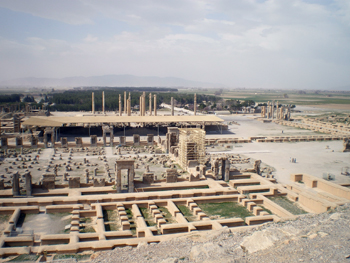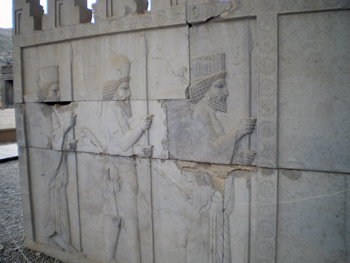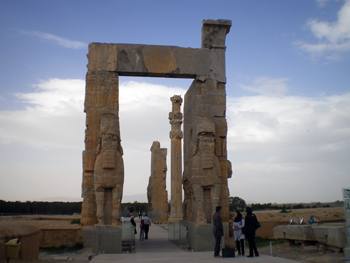
by Neil Middelton
What was once the ‘most hated city in the world’ is now an empty and silent ruin. As well as being the most hated of cities it was also one of the richest and most astounding, once famous for its wealth and beauty. Today Persepolis is an isolated ruin in the desert of Southern Iran. It stands empty not just because of its desert location but because it is deep in Iran, a country at once hospitable but seldom visited.
A journey to Persepolis will generally begin in the city of Shiraz. This small city, famous for gardens and poets, is worth a visit in itself. Its two famous features combine in the tomb of the 14th century poet Hafez. Set within a peaceful walled garden, surrounded by orange trees, the tomb is always crowded with adorers of the poet reciting his verses and laying hands on the marble slab of the grave. The desert city is brightened up by a plethora of blue onion-domed mosques and madrassas which dot the low skyline.
 It takes about an hour by car to cross the 70 kilometers of straight desert road to get to Takht-e-Jamshid, Persepolis. A little way outside the site are the rock-cut tombs of Naksh-e-Rustam. High up on a flat rock face the idealised figures of several Achaemenid kings glare out from a set of royal tombs. Cut so high that they were only accessible with ropes, I have to crane my neck and strain my eyes to make out the images of several Persian kings, the builders of Persepolis. Below the tombs the later Sassanian dynasty also left a vivid reminder. In this image the Iranian king Shapur I, sits tall astride his war-horse whilst in front a Roman emperor bends a knee and begs the king for mercy. All these thousands of years later the tombs and images still retain their main purpose of demonstrating the power of the Persian kings.
It takes about an hour by car to cross the 70 kilometers of straight desert road to get to Takht-e-Jamshid, Persepolis. A little way outside the site are the rock-cut tombs of Naksh-e-Rustam. High up on a flat rock face the idealised figures of several Achaemenid kings glare out from a set of royal tombs. Cut so high that they were only accessible with ropes, I have to crane my neck and strain my eyes to make out the images of several Persian kings, the builders of Persepolis. Below the tombs the later Sassanian dynasty also left a vivid reminder. In this image the Iranian king Shapur I, sits tall astride his war-horse whilst in front a Roman emperor bends a knee and begs the king for mercy. All these thousands of years later the tombs and images still retain their main purpose of demonstrating the power of the Persian kings.
Arriving at the ‘most hated city in the world’ I cross the empty car park, its modern drabness a poor preparation for the antique splendours beyond. I seem to be the only person here. Even the ticket sellers are invisible behind the dark kiosk windows. The jewel of Iranian heritage is just for me. This is one of the delights of Iran, a beautiful country full of riches yet devoid of tourists. In the complex itself just a few people slowly amble around, dwarfed by the size of the columns and gateways towering above them.
 Over two thousand years ago people trekked into the Southern Iranian desert bearing tribute to the mighty Persian Empire whose king sat enthroned in the courtyards and spacious halls of Persepolis. This gave the grand city its reputation as the most hated in the world and ultimately caused its fiery destruction by Alexander the Great. It never recovered from this destruction and the hollowed out shade of the city was left abandoned to the desert for centuries.
Over two thousand years ago people trekked into the Southern Iranian desert bearing tribute to the mighty Persian Empire whose king sat enthroned in the courtyards and spacious halls of Persepolis. This gave the grand city its reputation as the most hated in the world and ultimately caused its fiery destruction by Alexander the Great. It never recovered from this destruction and the hollowed out shade of the city was left abandoned to the desert for centuries.
The city was a complex of palaces sitting atop a terrace nestled beneath the low ‘Mountain of Mercy’. Construction began with Darius I at the end of the 6th century BC with much of the work being carried out by his successor, Xerxes I. The palaces served as the ceremonial centre of the vast empire and they were built to impress. Sadly all that remains are broken pieces. Columns and gateways rise up independently from each other and are surrounded by an empty void as if the rest of the palace has instantly disappeared. Still, these fragments are enough to give an idea of the grandeur of this city in the desert.
 Once in the site, I came first to the impressive Gate of All Nations. The name referring to the subjects of the empire who would have had to pass through here. Above me loomed two huge human headed winged lions, their eroded bodies incised with the vertical and horizontal lines of three different languages which proclaim Xerxes I as their builder. The grand courtyard these beasts guard having long since vanished their intimidating bulk at least offers some protective shade. A little further on a finely carved capital of two bull’s heads lays flat on the ground. Unlike much else here they look fresh, pristine, as if just carved out of gleaming marble. It’s difficult to imagine that their huge weight could once have been hauled up to top a slender column.
Once in the site, I came first to the impressive Gate of All Nations. The name referring to the subjects of the empire who would have had to pass through here. Above me loomed two huge human headed winged lions, their eroded bodies incised with the vertical and horizontal lines of three different languages which proclaim Xerxes I as their builder. The grand courtyard these beasts guard having long since vanished their intimidating bulk at least offers some protective shade. A little further on a finely carved capital of two bull’s heads lays flat on the ground. Unlike much else here they look fresh, pristine, as if just carved out of gleaming marble. It’s difficult to imagine that their huge weight could once have been hauled up to top a slender column.
Contrasting with the barren empty spaces the surviving walls are vividly sculptured. Many of them so fresh that the stripped ruin seems populated by the ghosts of its ancient inhabitants. As I walked around I came face to face with the soldiers who guarded the king and expanded his empire. Called Immortals by the Greeks, they stand in profile both hands clasping a long spear with a bow slung across the shoulder. Their faces framed by elaborately swirling beards and hair. The King sat enthroned high up, above all. Hovering protectively over his head was the disc of the god Ahuramazda, its two outstretched wings enveloping the seated King.
 One of the finest surviving elements of the site is the grand staircase which led to the Apadana Palace. The sides of the stairs contain some of the best surviving sculpture. It was here that the subject peoples would have to come bearing tribute. At the bottom of the staircase a lion grapples fiercely with a fleeing bull. This common piece of Persian iconography is still striking today. Climbing the staircase I was accompanied by the subject peoples. Greeks, Egyptians, Scythians, Afghans and a myriad others all processing up the steps to the palace at the top. The steps are cut deliberately shallow so you have to slow your pace and walk carefully before entering the presence of the King.
One of the finest surviving elements of the site is the grand staircase which led to the Apadana Palace. The sides of the stairs contain some of the best surviving sculpture. It was here that the subject peoples would have to come bearing tribute. At the bottom of the staircase a lion grapples fiercely with a fleeing bull. This common piece of Persian iconography is still striking today. Climbing the staircase I was accompanied by the subject peoples. Greeks, Egyptians, Scythians, Afghans and a myriad others all processing up the steps to the palace at the top. The steps are cut deliberately shallow so you have to slow your pace and walk carefully before entering the presence of the King.
Reaching the top of the staircase little is left of the Apadana palace, a large square hall with high ceilings supported by an estimated 72 columns. Only around 13 of those columns are standing scattered around. The empty platform gives little hints of the spectacle this place would have presented. With roofs made of huge wooden beams held aloft by those towering columns and walls completely decorated, the palace would have been one of the great sights of the ancient world. In such a fine place the Persian kings gave their official audiences.
In between the Apadana and the low mountain sit the scant remains of a number of other smaller palaces, halls and buildings. Whilst many of them are little more than a line of column bases and wall foundations the few standing walls and gateways bare some more remarkable images. From them we get some hints of the cosmological view of the Persians as we see the Kings fighting and overcoming a variety of wild beasts and monsters. These images were meant to show the King as the upholder of order opposed to the chaos of disorder.
 The fighting animals, strong soldiers and exotic subjects which lined the walls and the sheer opulence of the place must have made entering Persepolis an intimidating experience. Many from beyond Persia would only have come to Persepolis under compulsion. It is not surprising then that it was such a feared and hated place, the object of vengeful dreams for many people, despite its beauty. Once Alexander the Great defeated Persia and captured the city he had it burnt to the ground before leaving. As the architectural symbol of the Persian Empire, Alexander reckoned he could not leave it standing. The fire would have quickly rose and engulfed the wooden beams of the roof and brought them crashing down. Traces of this fiery end can still be seen across the site which was never rebuilt.
The fighting animals, strong soldiers and exotic subjects which lined the walls and the sheer opulence of the place must have made entering Persepolis an intimidating experience. Many from beyond Persia would only have come to Persepolis under compulsion. It is not surprising then that it was such a feared and hated place, the object of vengeful dreams for many people, despite its beauty. Once Alexander the Great defeated Persia and captured the city he had it burnt to the ground before leaving. As the architectural symbol of the Persian Empire, Alexander reckoned he could not leave it standing. The fire would have quickly rose and engulfed the wooden beams of the roof and brought them crashing down. Traces of this fiery end can still be seen across the site which was never rebuilt.
Passing by Persepolis some years later and looking on the charred ruins of the once opulent city he had destroyed, Alexander is said to have regretted his rash, youthful action. Looking at the exquisite traces isolated out in the desert today, we too can only have regret.
If You Go:
♦ Persepolis lays 70 kilometers outside of Shiraz, many hotels and travel agency can arrange transport and tickets for around $25
♦ Travel to Iran requires a pre-arranged visa which are organised by travel agencies such as www.iranianvisa.com
♦ Tour Persepolis with a Local Guide
About the author:
Neil Middleton is an archaeologist with a degree in Ancient History and Archaeology from the University of Manchester. As well as working on excavations in Greece, Cyprus and England he has travelled around historic sites in the Middle East and Central Asia and is now living in Athens, Greece.
All photos by Neil Middelton.


